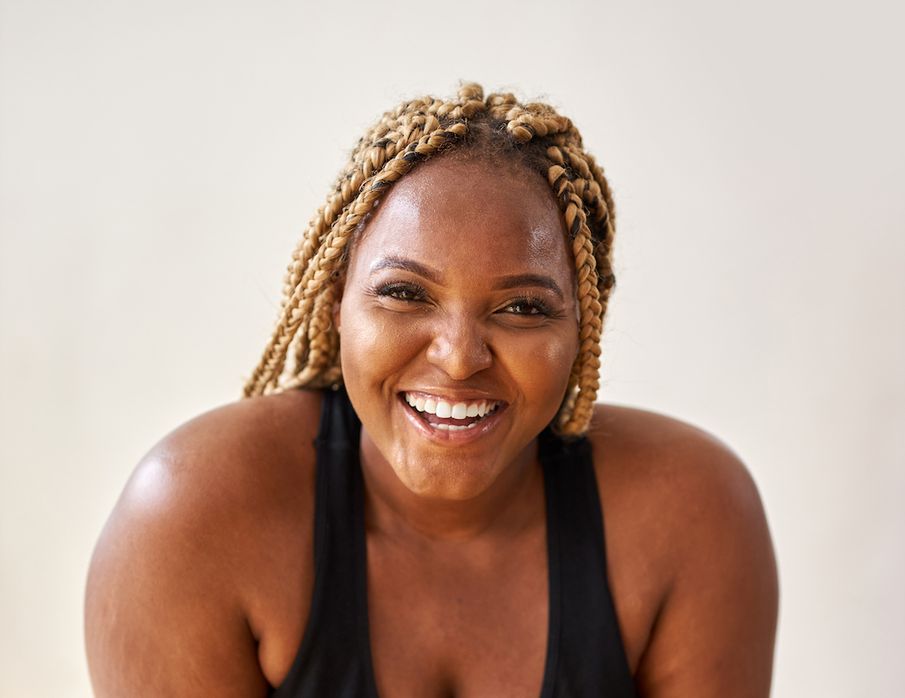The phrase has been with us for years, and was recently added to the Oxford English Dictionary, but the debate around the subject is only just getting started
You’ve probably encountered the term ‘body positivity’ over the past few years. It’s a phrase that has been propelled to the forefront of cultural conversations, sparking critical discussions around poor body image in our society. Now, the term has been added to the dictionary.
‘Body positivity’ was among 1,400 new words, sub-entries, and revisions introduced to the Oxford English Dictionary in its March 2021 update. The update, which included the addition of ‘body-shaming’ and ‘fat-shaming’ to the roster, reflects a growing recognition of the dangers that exclusionary body ideals pose to our mental health.
A 2020 survey by the Women and Equalities Committee found that 62% of women feel negatively about their bodies. Pressures from diet culture, exposure to heavily edited and sexualised images, and a lack of visual representation of diverse body types, were all cited as causes of low self-esteem.
With more than 16 million posts shared under the ‘body positive’ hashtag on Instagram, the term has united people across the globe in retaliation against toxic societal expectations to look and behave a certain way.
“Awareness of the harms associated with the pressure to conform to narrow and restrictive beauty norms certainly predate social media,” Fiona McPherson, senior editor at the OED, tells me. “But it is fair to say that social media has provided an avenue for people – especially women – to challenge this, as well as being a vehicle for the perpetuation of such standards.”
The OED defines ‘body positivity’ as an ‘acceptance and appreciation of the human body, especially one’s own,’ and ‘the promotion and celebration of a realistic body image’ – principles we all should champion.

Where does ‘body positivity’ come from?
‘Body positivity’ owes much of its current prominence to the fat acceptance movement, which originated in the 1960s. Fat activists campaigned to end anti-fat discrimination, and to liberate fat bodies from weight stigma.
During the late 2000s and early 2010s, the term ‘body positivity’ was integrated into fat acceptance rhetoric, gaining momentum among digital communities, led predominantly by plus-size women of colour.
Although most discussions of ‘body positivity’ did, and still do, emphasise the rejection of appearance norms, evidence from the term’s past usage also reflect a broader focus on combating all forms of bodily shame and stigma.
“The earliest example, from 1994, uses the term in the context of feeling comfortable with physical intimacy and displays of affection, rather than with one’s appearance” explains Fiona McPherson. “We see early examples, too, which show the term is associated with the feminist and gay rights movement, and has to do with a rejection of the social shaming of physical behaviour, anatomy, and processes.”
Body image is influenced by myriad social expectations prescribing what makes a ‘good’ body. These expectations are also embedded in wider forms of discrimination, including racism, sexism, colourism, and ableism.
“It’s important to discuss body image through an intersectional lens, to consider the layered and interacting appearance pressures that individuals and groups experience” says Dr Nadia Craddock, a researcher at the Centre of Appearance Research. She tells me that, although having an appearance that does not conform to societal appearance standards doesn’t mean a person cannot have a positive body image, being subject to discrimination and prejudice based on one’s appearance increases the risk of negative body image.
This is reflected in recent body image surveys. According to the Women and Equalities Committee report, 71% of disabled respondents feel poorly about their body most of the time, and 40% of LGBT adults experience shame due to their body image. Racialised appearance standards also place extensive pressure on the body image of Black and minority ethnic women, who bear the compounded strain of gendered and racial oppression.
At the heart of ‘body positivity’ is a mission to promote the acceptance and liberation of marginalised bodies, in particular, fat, Black and brown, queer, and disabled bodies that are routinely discriminated against. But portrayals of body positivity today regularly exclude the very bodies which need it most.
The changing meaning of ‘body positivity’
With the buzz surrounding ‘body positivity’ catapulting it into mainstream conversations, early advocates have expressed concerns that its political strands are being erased.
“It’s led to a dilution of the term,” says Michelle Elman, a life coach and the author of Am I Ugly? “People take it literally, and think that it means to be positive about your body.”
Dr Nadia Craddock agrees. “It’s very easy to think about the terms ‘positive body image’ and ‘body positivity’ as one and the same – understanding the latter term as short-hand for the former.” She adds that “body positivity is commonly reduced to mean loving your body and believing yourself to be beautiful”.
Increasingly, ‘body positivity’ is seen as synonymous with ‘self-love’ or ‘body confidence,’ and many businesses have capitalised on this conflation in order to sell us things with the promise of improving our relationship with our bodies. Yet campaigns heralding themselves as ‘body positive’ overwhelmingly feature slim, white, and non-disabled bodies – upholding the very ideals it strives to overturn.
"At the heart of ‘body positivity’ is a mission to promote the acceptance of marginalised bodies. But portrayals of body positivity today regularly exclude the very bodies which need it most"
Michelle Elman explains that the mainstream conflation of ‘body positivity’ with ‘body confidence’ has left less space to talk about the discrimination and oppression that marginalised bodies face.
Conversations around cultivating individual positive body image have a crucial place in promoting mental health, but we need to reserve space within language for challenging bodily discrimination on a societal level as well.
Terms to use instead of ‘body positivity’
While the fluid and evolving nature of language is in part what enabled the rise of ‘body positivity’, when a term is so strongly tied to a political movement focused on empowering marginalised communities, it’s important to ensure messages of social justice and body liberation remain reflected in its use.
Perhaps a more applicable term for what many people refer to as ‘body positivity’ is actually ‘body acceptance’. This term allows us to focus on making peace with our bodies without overwriting the specific struggles of those who founded the movement.
‘Body acceptance’ is not the belief that our bodies are perfect or beautiful, but that they are enough. This belief also forms the foundation of ‘body positivity,’ which advocates that all bodies deserve respect and acceptance.
Another term that has gained more attention in recent years is ‘body neutrality’. Body neutrality rejects the belief that, in order to make peace with our bodies we have to love or even accept the skin we’re in. Instead, we’re reminded that our value is independent of our bodies. We are so much more.
To connect with a counsellor to discuss body image or discrimination, visit counselling-directory.org.uk


Comments